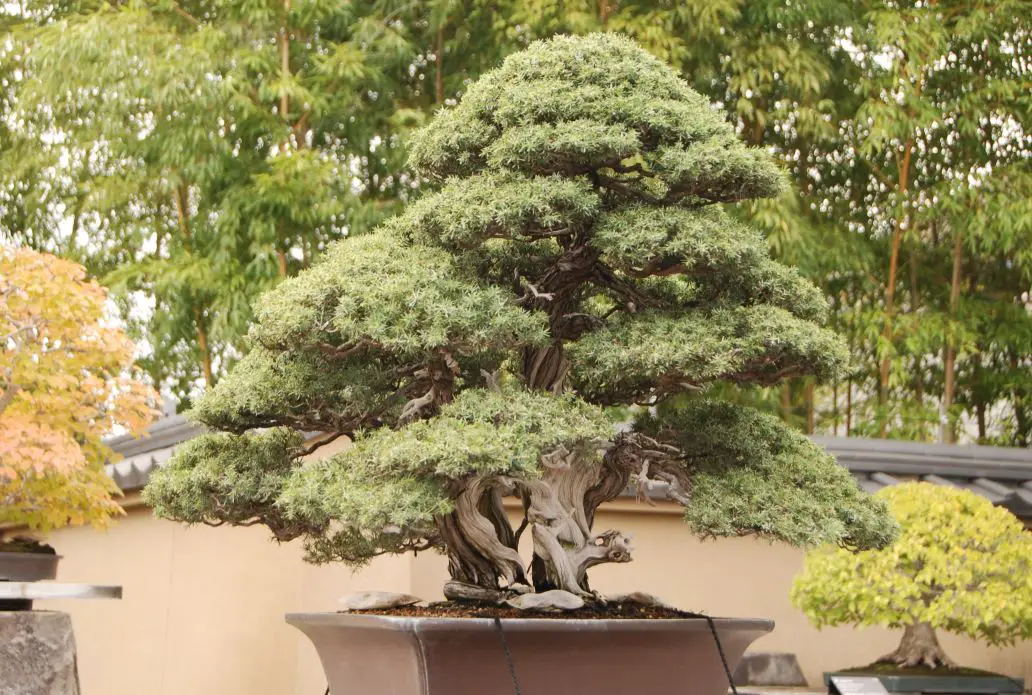There are quite a few species of juniper but not all of them are equally fitting for bonsai cultivation. Juniper species best suited for bonsai are Shimpaku juniper, needle juniper, Common juniper and Rocky Mountain juniper.
Can you use any juniper for bonsai?
Junipers are a popular choice for bonsai enthusiasts due to their hardiness, beautiful foliage, and suitability for shaping and styling. However, not all junipers are equally suitable when it comes to bonsai cultivation.
Juniper at a glance

Junipers are coniferous trees or shrubs that belong to the cypress family (Cupressaceae). Depending on the classification, there are around 50 to 70 species of junipers in the Northern Hemisphere, from North America, Europe, to Asia.
Junipers are known for their evergreen foliage, which ranges from dark green to silvery in color. They come in a variety of sizes and shapes. Some junipers are small, compact shrubs growing horizontally, while others can grow over a 100 feet.
Junipers are hardy and can withstand a wide range of growing conditions. They are tolerant of drought, heat, cold, and are generally easy to care for.
Juniper needle types
Junipers can be classified based on the type and arrangement of their needles. There are 2 main types of juniper needles:
- Needle-like needles
- Scale-like needles
Needle-like needles
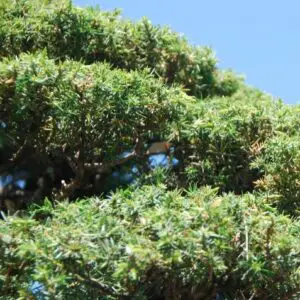
Needle-like needles (juniper)
These needles are sharp and pointed, and grow in pairs or threes along the stem. They are usually less than half an inch long and are found on species like needle juniper and common juniper.
Scale-like needles
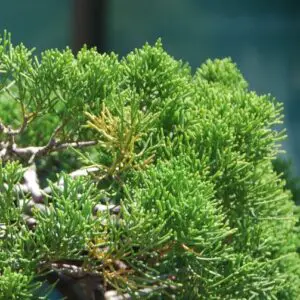
Scale-like needles (juniper)
These needles are like scales with blunt tips that overlap each other like shingles on a roof. They are usually less than a quarter inch long and are found on species like Chinese juniper and Rocky Mountain juniper.
Some juniper species can have a combination of needle types depending on the growing conditions. For example, the Chinese juniper can have both awl-shaped and scale-like needles, especially when it is young.
Characteristics of a good juniper for bonsai
There are quite a few species of juniper but not all of them are equally suitable for bonsai. Some junipers are better suited for bonsai than others and are more commonly used because they have desirable characteristics as a bonsai tree.
When selecting a juniper for bonsai, you should be looking for the following characteristics that are desirable for a bonsai.
Needle size
Ideally, a good juniper for bonsai should have short needles that are proportional to the size of the bonsai. Small needles create a sense of scale and can help achieve a natural and realistic appearance to a bonsai tree.
Needle color
As evergreen, beautiful green foliage is highly valued for an attractive appearance.
Foliage and Branching
The ability to prune the branches and foliage freely and the tree producing new ones afterward is also important for creating and maintaining the desired shape and style. Junipers are generally well-suited to bonsai techniques, including pruning and shaping.
Also, a good juniper bonsai has dense foliage, giving the tree a full, healthy appearance. It should have a well-ramified branching structure as well which provides a good foundation for shaping and styling of the tree.
Resinous
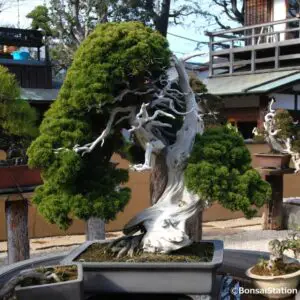
100 million yen Japanese juniper bonsai with amazing deadwood feature.
The presence of abundant resin in the wood can make them resistant to corrosion and suitable for creating bonsai deadwood, which is one of the distinctive features of juniper bonsai.
If you are interested in bonsai deadwood and how to create it, the following posts might be helpful.
“Creating Jin and Shari Bonsai: A Step-By-Step Guide” (link here)
Hardiness
An ideal juniper bonsai, or bonsai in general, should be able to tolerate a wide range of temperatures and climates. Junipers are generally known for their hardiness and ability to tolerate drought, cold, and heat.
Best juniper species for bonsai
The best juniper species for bonsai cultivation are:
- Shimpaku juniper
- Needle juniper,
- Common juniper, and
- Rocky Mountain juniper.
Shimpaku juniper (Juniperus chinensis var. sargentii)
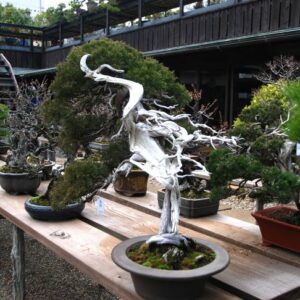
Japanese Shimpaku juniper (masterpiece)
Shimpaku juniper is one of the best juniper species for bonsai. It has a compact growth habit with dense foliage and beautiful small needles, making it ideal for both smaller and larger bonsai styles. It is suited for the bonsai deadwood technique, which gives them a distinctive and interesting appearance as bonsai trees.
Other common names
Other common names for Shimpaku juniper include:
- Itoigawa juniper,
- Itoigawa Shimpaku,
- Itoigawa Shimpaku juniper,
- Kishu juniper,
- Japanese juniper,
- Sargent Juniper, and,
- Sargent’s Chinese juniper.
While Shimpaku juniper is sometimes called Chinese juniper, they are not the same to be exact. Shimpaku juniper (Juniperus chinensis var. sargentii) is a variation of the Chinese juniper (Juniperus Chinesis).
In other words, Shimpaku juniper and Chinese juniper are the same species sharing the same genetic markup but differ in some specific traits such as size, color, or growth habit, all of which make a huge difference in bonsai cultivation.
As to size, Shimpaku juniper only grows 2 feet tall while the Chinese juniper grows up to 50 feet (15m).
Itoigawa vs. Kishu Juniper
The Chinese juniper (Juniperus Chinesis) had been used for bonsai cultivation for centuries until the discovery of the Shimpaku juniper in the Western part of Japan at the end of the 19th century.
They named this variation of the Chinese juniper “Shimpaku”, meaning “true cypress” (cf. Shimpaku juniper is a cypress family), because they thought it is the most beautiful and valuable as a bonsai tree.
With its beautiful needle and dwarfed growth, the Shimpaku juniper soon became very popular among bonsai growers.
In 1910, another slightly different variation of Shimpaku juniper was found in the Itoigawa region, Northwestern Japan. This variation of juniper was named “Itoigawa Shimpaku” to distinguish it from the other Shimpaku found earlier.
Itoigawa Shimpaku had smaller, shorter needles and a more ramified branch structure. People are excited and this variation became mainstream as it was better suited for bonsai cultivation.
Since then, many cultivars of the Shimpaku juniper were made, one of which was Kishu Shimpaku juniper.
Compared to Itoigawa Shimpaku, Kishu Shimpaku has longer, thicker needles in lighter green color and a smoother bark pattern. It is hardy and can tolerate extreme heat and strong sunlight. It can endure hard pruning (or wrong pruning) as well, which is perfect for a beginner.
When people say “Shimpaku juniper” nowadays, it refers most likely to Itoigawa Shimpaku juniper due to its popularity.
In short,
- Shimpaku juniper is a variation of the Chinese juniper (they are not exactly the same).
- Itoigawa Shimpaku juniper is a kind of Shimpaku juniper.
- When we say Shimpaku juniper, it refers to Itoigawa Shimpaku juniper in most cases.
- Kishu Shimpaku juniper is a cultivar of the Shimpaku juniper.
- Itoigawa and Kishu junipers have different needles size and bark patterns.
- There are other cultivars/variations of Shimpaku juniper, including Tohoku Shimpaku juniper.
There is also a juniper called “Tanuki Shimpaku”, which is not a type of Shimpaku juniper but a bonsai made by attaching a living tree to a piece of deadwood to create a new bonsai tree.
For more about Tanuki Shimpaku, the following article might be informative.
Native land
Shimpaku juniper is native to certain regions of Japan while Chinese juniper can be found in China, Korea, Russia as well as Japan. With excessive exploitation, though, Shimpaku juniper is on verge of extinction in its natural habitat and now only a handful of them grow in nature.
Natural habitat
Shimpaku juniper mainly grows naturally in high mountains (above 1,000 meters above sea level) in infertile rocky areas or on rocky seashores.
It is hardy to USDA Zone 3 to 9.
Size
Shimpaku juniper is slow-growing and only reaches a height of 2 to 3 feet.
Appearance
Foliage

Shimpaku juniper needles
Shimpaku juniper has fine, dense foliage with short, and compact needles that are dark bluish-green in color. Depending on the cultivar, the needle color can be pale yellowish green.
Its needles are scale-like but needle-like leaves may appear when heavily pruned (maybe from stress) or on younger trees.
Branches and Trunks
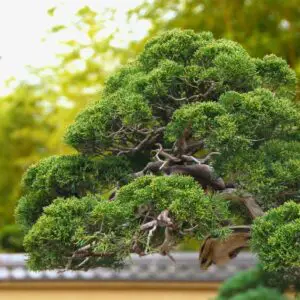
Shimpaku juniper branching
Branches are finely ramified and the trunk grows naturally with bends and twists. Its wood contains a lot of resins which makes it perfect for creating bonsai deadwood.
Bark

Shimpaku juniper bark
The bark of this juniper is grayish- or reddish-brown and peels off in thin strips with age, exposing a smooth, cinnamon-colored bark underneath.
Needle juniper (Juniperus rigida)
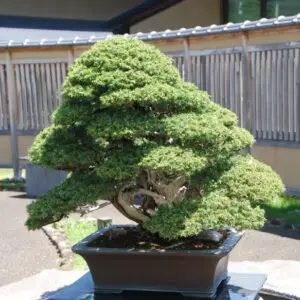
Needle juniper
Needle junipers are one of the best junipers for bonsai making. They are hardy and vigorous and have small needle-like leaves in beautiful light green color. Their branch structures are well-ramified that can be easily pruned and styled in any bonsai style.
It is suited for the bonsai deadwood technique, which gives them a distinctive and interesting appearance as bonsai trees.
Other common names
Other common names for needle juniper include:
- Temple juniper and
- Tosho juniper
Needle juniper is also called temple juniper because it is supposedly planted traditionally on temples or other sacred grounds in Japan.
I said “supposedly” because I don’t see many needle junipers around temples and shrines in Japan. Yes, evergreens are a symbol of good luck and needle juniper can well be planted in the sacred ground in some places. But common evergreens we see at temples are Japanese cedars, pines and cypresses and needle junipers aren’t one of them.
Native land
Needle juniper (Juniperus rigida) is native to China, Korea, Japan, and southeastern Russia. It is also naturalized in some of the warmer states in the US.
Natural habitat
Needle juniper grows in barren, mountainous land as well as coastal areas. It has very strong vigor and can withstand heat, wind and rain, strong sunlight as well as drought. It is resistant to air pollution and grows well in cities.
It is slightly sensitive to cold compared to Shimpaku juniper. It is hardy to USDA Zone 5.
Size
Needle juniper grows to a height of 33 feet (10m) and a trunk diameter of up to 20 inches (50 cm).
Appearance
Foliage
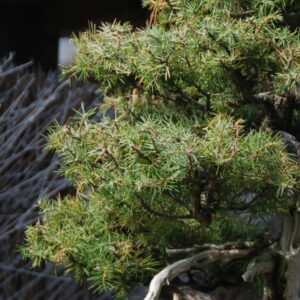
Needle juniper needles
Needle juniper, as the name suggests, has needle-like leaves which are short and dense. They are light emerald green with white lines in each needle which does not change throughout the season.
Depending on the variation and where the tree came from, some have markedly different leaf characteristics than others.
Branches and Trunks
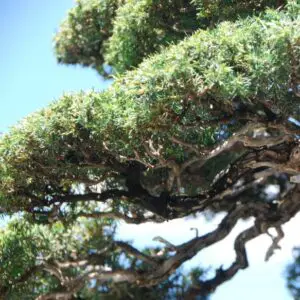
Needle juniper branching
Needle juniper has a strong germination ability. It often sprouts near the bottom of the trunk, which is good for creating any tree shape from large bonsai to mini bonsai.
With the ability to sprout strongly, leaves and branches can be pruned rather freely. Branches are less likely to die back and many new leaves will appear after pruning.
The wood is hard and contains a large amount of resin, making it suitable for making bonsai deadwood.
Bark
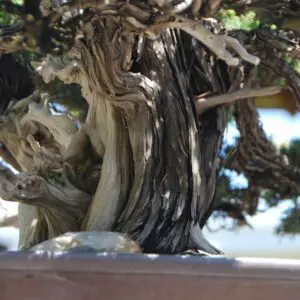
Needle juniper bark
The bark of needle juniper is dull gray, fibrous, and shallowly fissured. After a few years of growing in a bonsai pot, it becomes more fissured and has the appearance of an old tree.
Common juniper (Juniperus communis)
Common juniper (Juniperus communis) has a low, spreading growth habit, reaching less than 18 inches (45 cm). It is native to a large part of the Northern Hemisphere from North America to Europe and Asia.
Common juniper is closely related to the needle juniper (Juniperus rigida) and has short, needle-like leaves typically with bright green color.
There are a lot of cultivars of common juniper such as Green Carpet and Pioneer with different tree sizes, needle colors and growth habits, and not all of them are suitable for bonsai cultivation. It is thus important to choose a variation with short, dense needles in a beautiful color, a well-ramified branch structure, and resinous.
It is more tolerant of cold temperatures than some other juniper species and hardy to USDA Zone 2.
Rocky Mountain juniper (Juniperus scopulorum)
Rocky Mountain juniper (Juniperus scopulorum) has a twisted, gnarled trunk with a wide range of sizes from 2 feet (60cm) to 30-40 ft (9-12 m) high depending on the cultivar. There are a lot of cultivars of this juniper that grow tall/short or wide/narrow with different needle colors, and not all of them are suitable for growing as a bonsai tree.
It is native to North America and grows at altitudes of 1600 to 9000 feet (500-2700 m) on dry, rocky soils. As such, it can withstand drought and cold weather (USDA hardiness zone 3).
With scale-like leaves in dark or light bluish-green, its branching structure is well-ramified and has dense foliage. This fine foliage sometimes makes it more delicate to handle for a beginner, though the tree itself is strong and vigorous.
Rocky Mountain juniper has amazing textured bark which is perfect for bonsai deadwood creation.

